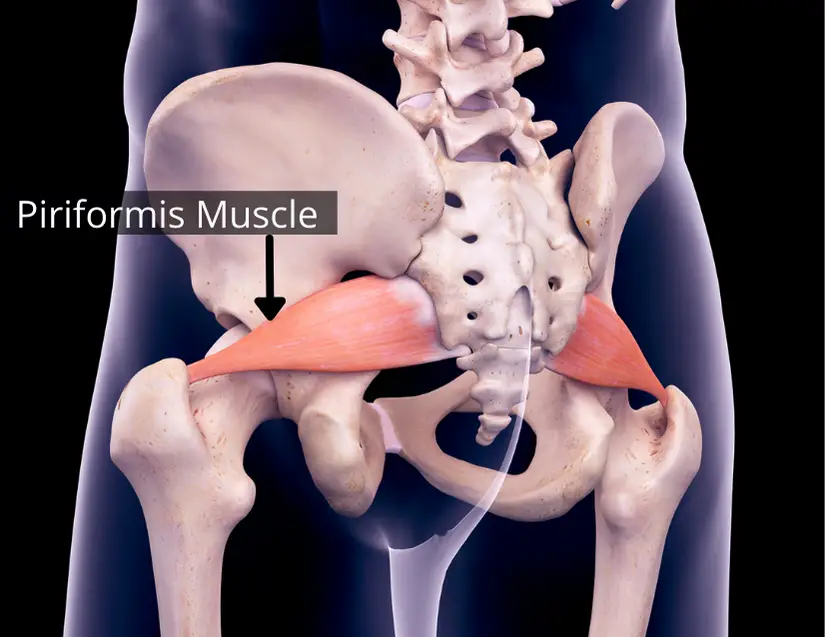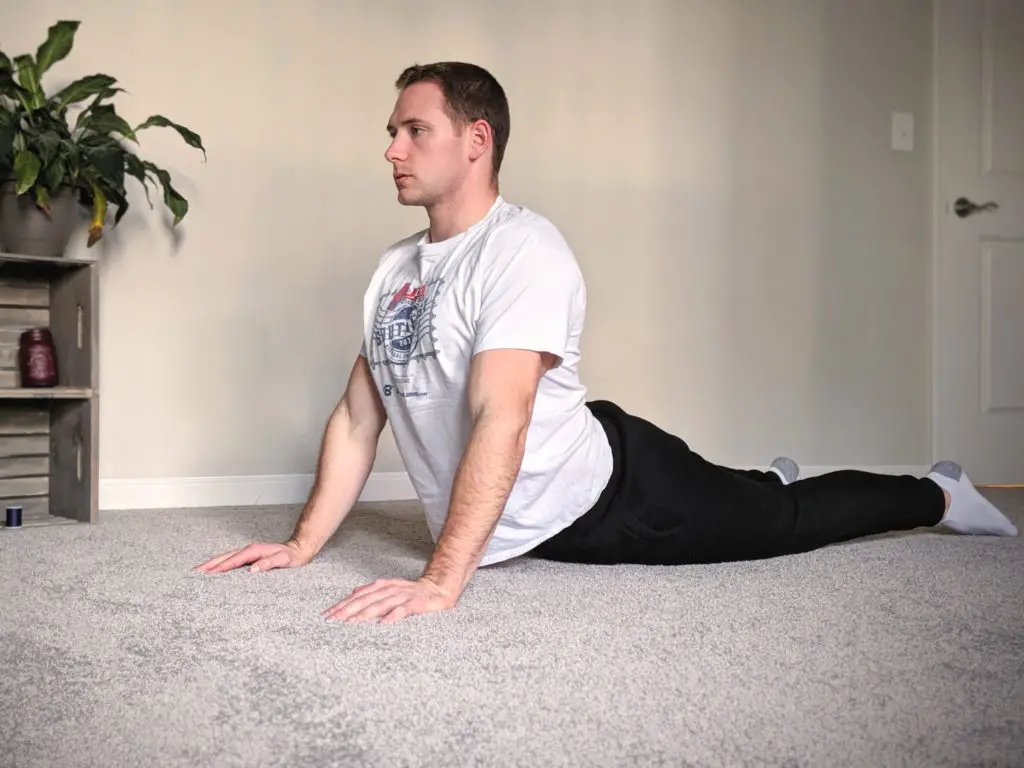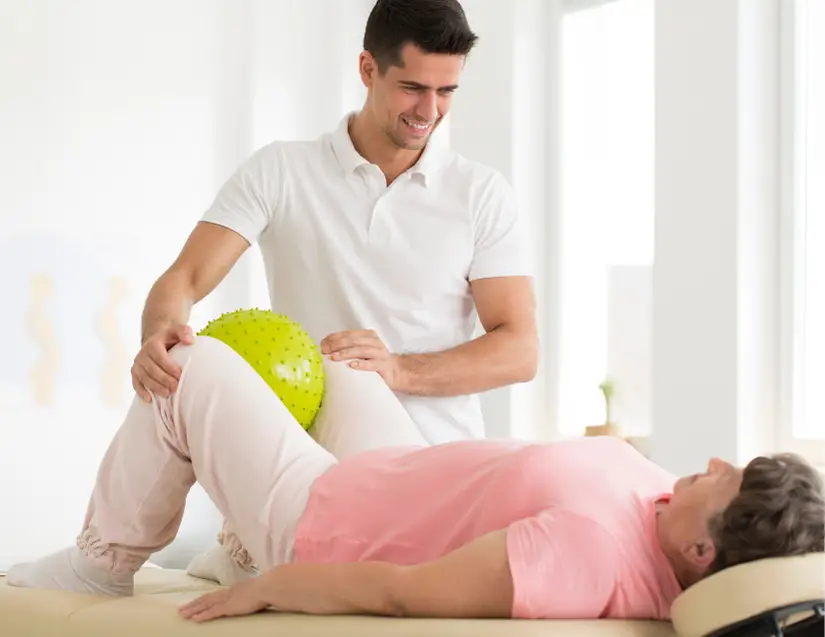SI joint problems are literally a pain in the butt. The sacroiliac joints can hurt at rest, with movement, and while standing or walking. SI joint dysfunction is especially common during pregnancy.
In this article you will learn about SI joint anatomy, function, and treatments to relieve pain (including exercises to do during pregnancy).
Anatomy
The sacroiliac joints sit on either side of the sacrum (located the bottom of the spine) where it connects with the right and left ilia (hip bones).

Strong cartilage and ligaments surround the SI joint, fortifying its stability and restricting motion. In this way, it’s opposite of the shoulder joint, which is highly mobile and less stable.
SI joint irritation causes pain at the PSIS (posterior superior iliac spine), also known as the dimple of Venus. People with SI joint pain point 1 finger to this area. This pinpoint posterior pelvic pain is known as the Fortin finger sign and research shows it indicates pain originating from the SI joint (1).

The SIJ can refer pain into the butt and down the back of your thigh. However, nerve irritation in the lumbar spine, colloquially known as sciatica or sciatic nerve pain, is a more common source of referred leg pain.
Function
The SI joints connect the lower body to the spine and upper body. The SI joints are sturdy, stable joints that move very little. They are designed to handle large forces.
The SIJs transfer force between the spine and the lower body. They also absorb and distribute forces from the lower body up the kinetic chain.
Does Stretching Help SIJ Pain?
Stretching can reduce SI joint pain…or exacerbate it. Most SI joint problems stem from too much mobility, especially pregnancy-related SI joint pain.
Stretching hypermobile (loose) connective tissues around the SI joint will likely worsen pain. Tight muscles around the SIJ occur when the body tries to stabilize this area and reduce joint motion.
If you decide to stretch the SIJ musculature, target the piriformis muscle. The piriformis attaches directly to the sacrum and influences SIJ mechanics. Just understand that stretching tight pelvic muscles may exacerbate symptoms.

To learn more about the under-recognized drawbacks of static stretching, check out 5 Reasons Stretching is Overrated.
A Little Controversy
The sacroiliac joint is the most controversial joint in the rehab world. Many clinicians treat SI joint dysfunction by (purportedly) repositioning the sacrum to correct abnormal motions or positions.

Other rehab experts point to research showing SI joint position palpation is unreliable and the SI joint doesn’t move much–only about 3 degrees (2, 3).
Instead of leaning on unreliable tests, some experts advocate a general treatment approach to the SI joint. Treatments aim to strengthen the musculature around the SI joint and reduce any muscle imbalances in strength or tone.
Avoiding aggravating activities is another key to recovery. High impact and single leg activities like running, jumping and walking in a walking boot induce significant shear forces on the SI joints. These activities can aggravate SI joint pain.
Pregnancy and SI Joint Pain
SI joint pain and pelvic pain are more common during pregnancy, affected about 50% of pregnant women (4).

Three major factors contribute to SI joint pain during pregnancy:
First, hormonal changes during pregnancy (such as increased relaxin) cause ligaments and connective tissue to loosen in preparation for childbirth. While these hormonal changes make labor and delivery easier, looser ligaments allow more motion in the SI joints. Excessive SI joint mobility often contributes to pain.
Second, weight gain due to pregnancy alters weight distribution and mechanics at the lumbar spine and SI joints. The body’s center of gravity shifts forward as pregnancy progresses. The extra weight and altered forces at the spine and pelvis can cause sacroiliac pain.
Finally, muscle tone and strength decreases during pregnancy as a natural result of reduced activity levels. With increased ligament laxity and less muscle tone to stabilize the SI joint, this area is more prone to irritation.
Does Heat or Ice Help?
Using a heating pad or an ice pack can provide temporary relief for SI joint pain. If heat or ice helps you sleep better or complete daily activities with less pain, go for it.
Use both, or whichever feels better. Or neither. You aren’t missing major benefits by not using heat or ice.
10 Proven Exercises for SIJ Pain Relief
Fortunately, several exercises offer SI joint pain relief.
Before doing any of these exercises, consult with your doctor about approved lying positions, especially if you’re pregnant. Lying on your back or stomach is often contraindicated during pregnancy.
The first 3 moves target the lumbar spine. Evidence-based physios use these types of motions to screen the lumbar spine before treating the SI joint (2).
Repeated motion testing is the best way to rule out low back pain and sciatica as the source of SI joint pain. SI joint and low back pain patterns are similar. Screening the lumbar spine is key to treating the SI joint effectively (2).
1) Repeated Lumbar Extension

Repeat extensions are most comfortably performed in prone. However, standing extensions work better for those who are pregnant or otherwise will try to maybe better for those uncomfortable on their stomach or who are pregnant. Perform in 15 repetitions, then reassess symptoms afterwards.

Major changes in your symptoms? You’re dealing with a lower back issue. You may find immediate back pain relief with repeated lumbar motions. It’s just a matter of finding the correct movement.
For more, check out the best-selling Treat Your Own Back book for further insights of self-managing this issue.
2) Side Glides in Standing
Individuals whose symptoms worsen with lumbar extensions often experience pain relief with frontal plane, side to side forces. This exercise is one route to pain relief via frontal plane forces.

Move the hips away from the side of pain, then return to a neutral starting position. Move further into the stretch each time.
Only perform this movement to one side. Try 10 to 15 reps, assessing for changes in symptoms afterwards.
3) Repeated Lumbar Flexion
Finally, repeated forward bending can alleviate lower back and posterior pelvic pain. If tolerable, do this exercise on your back, pulling your knees to your chest.

Alternatively, sit in a chair with your feet spread 2-3 feet apart. Bend forward, reaching your fingers to the floor. Hold for a few seconds, then sit up slowly. Repeat 10 times.
When one repeated motion reduces pain or improves function, it’s called a “directional preference.” Keep doing the beneficial repeated movement until you feel better (or it stops helping).
The next 7 exercises target muscle groups around the pelvis. These moves aim to normalize strength and muscle tone around the SI joint.
4) Isometric Hip Abduction
Lie your back with your knees bent and feet flat on the floor. Gently push your knees outward into a belt, band or a partner’s hands positioned on your outer thighs. You can also perform this exercise in sitting.
Hold for 5 seconds, then relax. Repeat 5 to 10 times.
5) Isometric Hip Adduction
Next, pull your knees together, squeezing a ball, folded blanket or pillow.

Hold 5 seconds and repeat 5 to 10 times. Start with a gentle squeeze and add force as tolerated.
6) Isometric Hip Flexion
Gently lift one knee and provide counterforce with your arms, pushing down on your knee. Hold 5 seconds and repeat 5-10 times. Perform in a seated or lying position.
7) Isometric Hip Extension
Push your foot down into the ground to engage your hamstrings and glutes. Hold 5 seconds, then relax. Perform 5 to 10 reps on each leg. Do this exercise in sitting or lying.
Research shows strengthening the glutes reduces SI joint pain (5).
8) Side Planks
Start on your side and lift your hips up. Support yourself with your bottom arm and the outside of your bottom foot.

For an easier modification, bend your knees and support yourself with your knees and the outside of your lower leg.
This is an excellent exercise to strengthen the abdominals, obliques and lateral glute muscles. All of these muscles contribute to proper core and pelvis function.
9) Front Planks
Perform a plank on forearms or hold the top of a push-up position. Maintain a straight line from your ears down to your ankles.

Front planks target the abdominals, obliques, quadriceps and hip flexors. However, If you’re dealing with diastasis recti (abdominal separation), talk with your doctor about whether front planks are appropriate for you.
10) Sit to Stands
Start seated in a normal chair. Cross your arms, then stand up. Slowly sit back down, taking 4 seconds to descend to the chair. Repeat 5 to 15 times. This exercise strengthens the quadriceps and gluteal muscles.
Bonus Tip
For SI joint issues due to hypermobility and joint laxity, an SI belt can work wonders. The belt wraps around your pelvis and stabilizes the SI joints, preventing excessive motion and pain.
It’s essential to wear it in the right location. So be sure to position the belt above your greater trochanters, the bony areas on the outside of your hips. Wearing an SI belt around these bones can cause bursitis and lateral hip pain, which is the last thing you need!
Check out this highly rated SI belt on Amazon.
Wrapping Up
SI joint pain, especially during pregnancy, stems from too much joint mobility. Gently strengthening hip and pelvis muscles can normalize muscle tone, reduce joint instability, and alleviate pain.
If you’ve been dealing with SI joint problems for a long time or suffer from chronic pain, it’s a good idea to work with a physical therapist to resolve your issues.
Physical therapy is one of the best treatment options for SI joint pain. After a thorough physical examination, a skilled PT will instruct you on the best exercises and treatments for your situation.
SI joint treatment often involves strengthening your abdominal muscles, back muscles and pelvic muscles to stabilize your SI joint. Plus, manual therapy is another proven treatment to reduce SI joint pain (6).
The good news is that PT is a great option, and pregnancy won’t last forever. Physical therapy can help you manage SI joint pain, whether pregnancy-related or not.
Readers: Are you dealing with SI joint issues? What makes it worse? What helps? Share your experience in the comments.
For more evidence-based insights you won’t find anywhere else, join the free, fast-growing Facts & Physio Newsletter. Plus, get The Recovery Checklist when you sign up.


2 thoughts on “Relieve SI Joint Pain Fast (10 Proven Exercises)”
Thank you for your article. My pain is at its worst when I am sleeping. It flares up when I adjust to my other side. I sleep on my side with a pillow between my legs. I am 50 a 50-year-old active female and have been suffering for over a year. I will try to incorporate these stretches into my daily routine.
Wishing you the best!
-Jacob